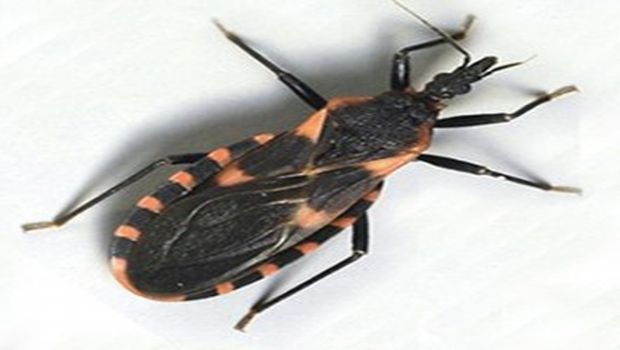Texas A&M Entities Helping Understand, Monitor Chagas Disease
To keep both animals and humans protected from Chagas disease, Texas A&M University System entities have been studying the parasite-host-vector interaction at sites in south-central Texas.


Chagas is caused by infection from the protozoan parasite T. cruzi, which is vectored by different species of triatomine bugs such as the one shown here. Photo courtesy of Texas A&M AgriLife Research
To keep both animals and humans protected from Chagas disease, Texas A&M University System entities have been studying the parasite-host-vector interaction at sites in south-central Texas.
Chagas is the common name for a disease transmitted by insects and animals that can cause severe symptoms, even death, in humans. It is responsible for an estimated 50,000 deaths annually in Latin American countries, according to the World Health Organization. The Centers for Disease Control and Prevention (CDC) estimates 8 million to 11 million people throughout Latin America have the disease, the majority of whom do not even realize they are infected.
Nineteen cases of Chagas in humans were reported to the Texas Health and Human Services Commission in 2013, but health officials feel the actual number of infections is higher due to misdiagnosis or non-reporting.
“Over the past several years, a number of animals in the South Central Texas area have shown symptoms of Chagas, and the presence of the disease had been confirmed through blood tests,” says Troy Luepke, a research assistant with Texas A&M AgriLife Research based in San Antonio who collected data used in the study.
In addition to AgriLife Research, other Texas A&M entities involved in the study included the Texas A&M Institute of Renewable Natural Resources and the wildlife and fisheries sciences department of the College of Agriculture and Life Sciences.
Luepke said there is additional concern in the scientific community that these instances will increase because of the possibility of dogs exposing humans to the disease. Dogs, especially those in rural areas, are more likely to come into contact with the triatomine bugs and other mammals that may transmit the disease.
Chagas is caused by infection from the protozoan parasite Trypanosoma cruzi, also known as T. cruzi. The parasite is vectored by certain triatomine bugs, which go by names like kissing bugs, assassin bugs, cone-nosed bugs and blood-suckers. These bugs take a “blood meal” from mammals and then transmit the parasite by depositing their waste into the wound.
In its acute stage, active symptoms of the disease may include fever, nausea, diarrhea, vomiting, fatigue and body aches. There may also be an enlargement of the liver or spleen or localized swelling in the spot where the initial infection occurred. In the chronic stage, the infection may remain dormant for years or even a lifetime, but sometimes severe cardiac issues, such as heart failure, heart attack or an enlarged heart, or intestinal problems occur.
“Chagas can produce digestive and cardiac complications in mammals, including free-ranging mammals like squirrels, skunks, opossums and raccoons, as well as in dogs and humans,” Luepke says.
Most of the data on Chagas infections collected in South Central Texas was from 2012 to 2014, but it was in the 1970s that Chagas was last studied in this area, he said.
“Many blood-feeding insects of the triatomine group have large populations in South Central Texas due to the habitat being conducive to their proliferation,” he says.
Understanding the life cycle of Chagas from host species such as raccoons, opossums and dogs to the bug vector is important to its control and management, says Dr. Roel Lopez, director of the Institute of Renewable Natural Resources, part of AgriLife Research. “Our approach has been a comprehensive review of many aspects of the disease, particularly with free-ranging wildlife populations."
Luepke said to estimate insect and mammalian host densities in different seasons and in different types of vegetation in South Central Texas, narrow sections of 1 meter by 100 meters were established on the test sites. Data gathered from these transected areas allowed project participants to also estimate the prevalence of T.cruzi through blood samples taken from known mammalian hosts found in these sections.
“We used infrared motion-activated trail cameras to determine the populations of larger mammals such as deer, raccoons, possums and squirrels, plus used small- to medium-sized traps to capture, mark and release smaller mammals, and bug traps to determine the population of triatomine bugs,” Luepke says. “We randomly placed one camera, one bug trap and 10 animal traps of different sizes in each transect. Samples were taken within each 100-meter line transection or at points placed every 10 meters.”
While the data showed a link between the triatomine bugs and host mammalians, the exact role of free-ranging animals in the infection equation is still largely unknown, Luepke says.
“But we did discover more instances of Chagas in raccoons and opossums than was previously theorized and not as much as expected in the smaller rodents we captured,” he adds.
Lopez said the research helped determine that one of the most effective preventive and habitat-management strategies should involve maintenance of open or manicured woodlands.
Source: Texas A&M AgriLife
Show, Tell, Teach: Elevating EVS Training Through Cognitive Science and Performance Coaching
April 25th 2025Training EVS workers for hygiene excellence demands more than manuals—it requires active engagement, motor skills coaching, and teach-back techniques to reduce HAIs and improve patient outcomes.
The Rise of Disposable Products in Health Care Cleaning and Linens
April 25th 2025Health care-associated infections are driving a shift toward disposable microfiber cloths, mop pads, and curtains—offering infection prevention, regulatory compliance, and operational efficiency in one-time-use solutions.
Phage Therapy’s Future: Tackling Antimicrobial Resistance With Precision Viruses
April 24th 2025Bacteriophage therapy presents a promising alternative to antibiotics, especially as antimicrobial resistance continues to increase. Dr. Ran Nir-Paz discusses its potential, challenges, and future applications in this technology.